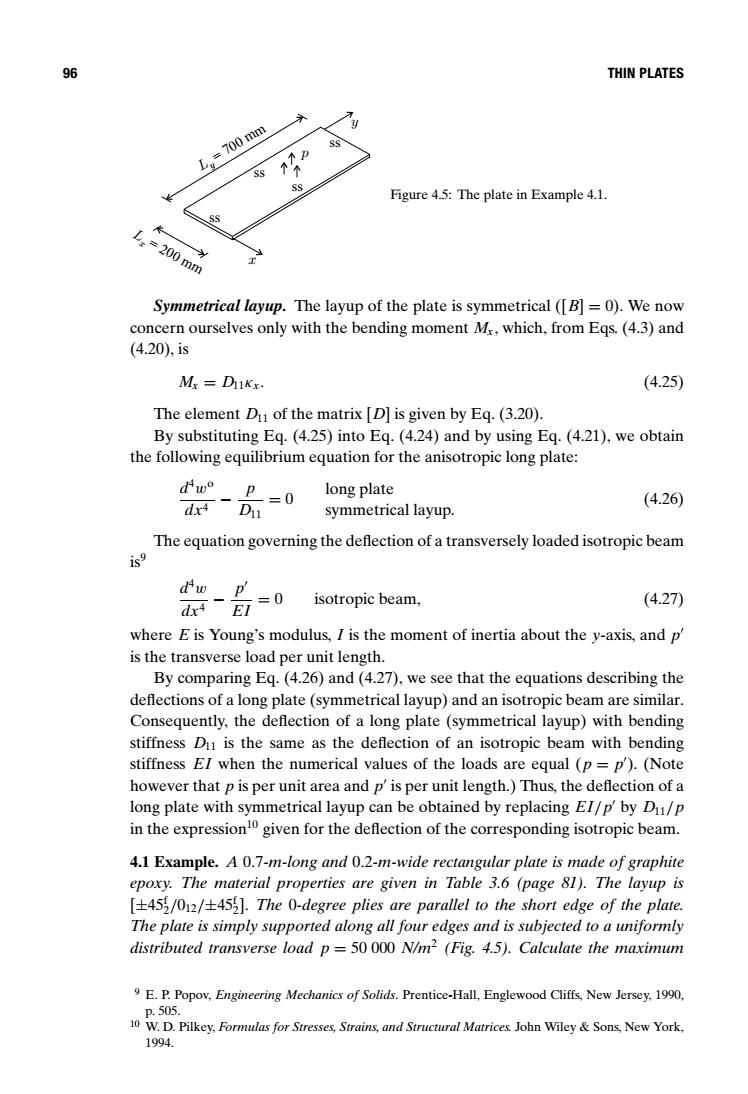正在加载图片...

96 THIN PLATES y L,=700mm SS SS Figure 4.5:The plate in Example 4.1. SS L.=200mm Symmetrical layup.The layup of the plate is symmetrical ([B]=0).We now concern ourselves only with the bending moment M,which,from Eqs.(4.3)and (4.20),is My D11Kx. (4.25) The element Di1 of the matrix [D]is given by Eq.(3.20). By substituting Eq.(4.25)into Eq.(4.24)and by using Eq.(4.21),we obtain the following equilibrium equation for the anisotropic long plate: dw°-p=0 long plate dx+Du (4.26) symmetrical layup. The equation governing the deflection of a transversely loaded isotropic beam 69 dw p' dxE=0 isotropic beam, (4.27) where E is Young's modulus,I is the moment of inertia about the y-axis,and p' is the transverse load per unit length. By comparing Eq.(4.26)and(4.27),we see that the equations describing the deflections of a long plate(symmetrical layup)and an isotropic beam are similar. Consequently,the deflection of a long plate(symmetrical layup)with bending stiffness Du is the same as the deflection of an isotropic beam with bending stiffness EI when the numerical values of the loads are equal (p=p').(Note however that p is per unit area and p'is per unit length.)Thus,the deflection of a long plate with symmetrical layup can be obtained by replacing El/p'by Du/p in the expression given for the deflection of the corresponding isotropic beam. 4.1 Example.A 0.7-m-long and 0.2-m-wide rectangular plate is made of graphite epoxy.The material properties are given in Table 3.6 (page 81).The layup is [+45/012/+4551.The 0-degree plies are parallel to the short edge of the plate. The plate is simply supported along all four edges and is subjected to a uniformly distributed transverse load p=50 000 N/m2 (Fig.4.5).Calculate the maximum 9E.P.Popov,Engineering Mechanics of Solids.Prentice-Hall,Englewood Cliffs,New Jersey,1990, p.505. 10 W.D.Pilkey,Formulas for Stresses,Strains,and Structural Matrices.John Wiley Sons,New York, 199496 THIN PLATES Lx = 200 mm Ly = 700 mm y x ss ss ss ss p Figure 4.5: The plate in Example 4.1. Symmetrical layup. The layup of the plate is symmetrical ([B] = 0). We now concern ourselves only with the bending moment Mx, which, from Eqs. (4.3) and (4.20), is Mx = D11κx. (4.25) The element D11 of the matrix [D] is given by Eq. (3.20). By substituting Eq. (4.25) into Eq. (4.24) and by using Eq. (4.21), we obtain the following equilibrium equation for the anisotropic long plate: d4wo dx4 − p D11 = 0 long plate symmetrical layup. (4.26) The equation governing the deflection of a transversely loaded isotropic beam is9 d4w dx4 − p EI = 0 isotropic beam, (4.27) where E is Young’s modulus, I is the moment of inertia about the y-axis, and p is the transverse load per unit length. By comparing Eq. (4.26) and (4.27), we see that the equations describing the deflections of a long plate (symmetrical layup) and an isotropic beam are similar. Consequently, the deflection of a long plate (symmetrical layup) with bending stiffness D11 is the same as the deflection of an isotropic beam with bending stiffness EI when the numerical values of the loads are equal (p = p ). (Note however that p is per unit area and p is per unit length.) Thus, the deflection of a long plate with symmetrical layup can be obtained by replacing EI/p by D11/p in the expression10 given for the deflection of the corresponding isotropic beam. 4.1 Example. A 0.7-m-long and 0.2-m-wide rectangular plate is made of graphite epoxy. The material properties are given in Table 3.6 (page 81). The layup is [±45f 2/012/±45f 2]. The 0-degree plies are parallel to the short edge of the plate. The plate is simply supported along all four edges and is subjected to a uniformly distributed transverse load p = 50 000 N/m2 (Fig. 4.5). Calculate the maximum 9 E. P. Popov, Engineering Mechanics of Solids. Prentice-Hall, Englewood Cliffs, New Jersey, 1990, p. 505. 10 W. D. Pilkey, Formulas for Stresses, Strains, and Structural Matrices. John Wiley & Sons, New York, 1994.�����